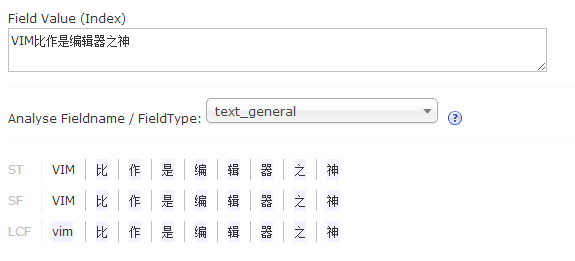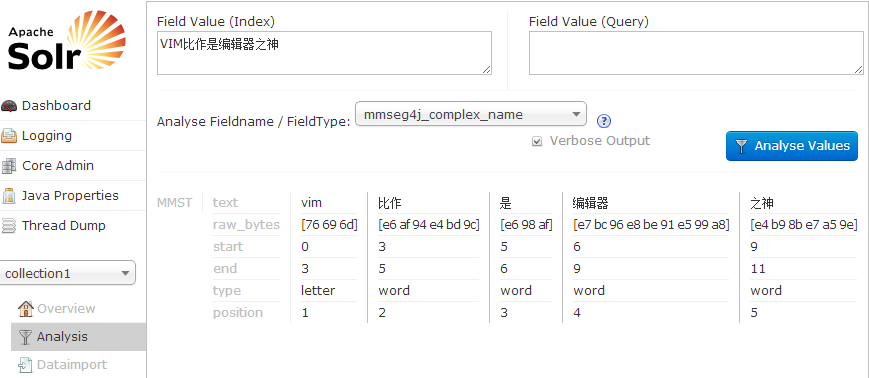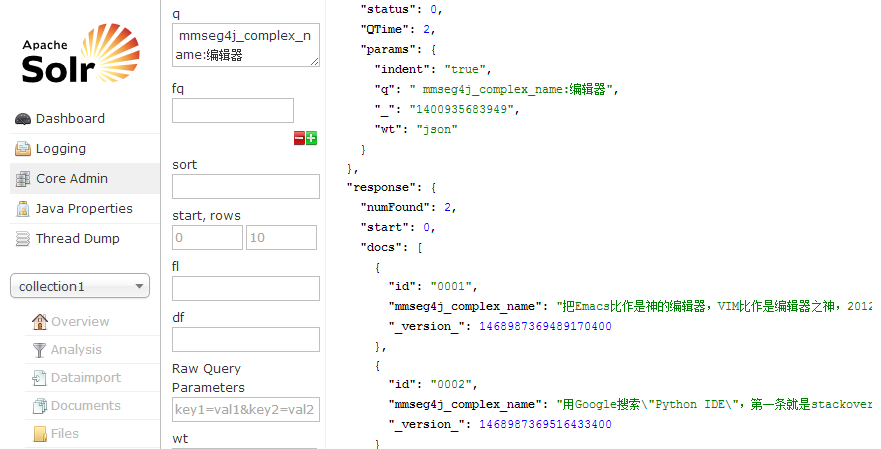| 全文检索引擎Solr系列——Solr核心概念、配置文件
Document
Document是Solr索引(动词,indexing)和搜索的最基本单元,它类似于关系数据库表中的一条记录,可以包含一个或多个字段(Field),每个字段包含一个name和文本值。字段在被索引的同时可以存储在索引中,搜索时就能返回该字段的值,通常文档都应该包含一个能唯一表示该文档的id字段。例如:
<doc>
<field name="id">company123</field>
<field name="companycity">Atlanta</field>
<field name="companystate">Georgia</field>
<field name="companyname">Code Monkeys R Us, LLC</field>
<field name="companydescription">we write lots of code</field>
<field name="lastmodified">2013-06-01T15:26:37Z</field>
</doc> |
Schema
Solr中的Schema类似于关系数据库中的表结构,它以schema.xml的文本形式存在在conf目录下,在添加文当到索引中时需要指定Schema,Schema文件主要包含三部分:字段(Field)、字段类型(FieldType)、唯一键(uniqueKey)
字段类型(FieldType):用来定义添加到索引中的xml文件字段(Field)中的类型,如:int,String,date,
字段(Field):添加到索引文件中时的字段名称
唯一键(uniqueKey):uniqueKey是用来标识文档唯一性的一个字段(Feild),在更新和删除时用到
例如:
<schema name="example" version="1.5">
<field name="id" type="string" indexed="true" stored="true" required="true" multiValued="false" />
<field name="title" type="text_general" indexed="true" stored="true" multiValued="true"/>
<uniqueKey>id</uniqueKey>
<fieldType name="string" class="solr.StrField" sortMissingLast="true" />
<fieldType name="text_general" class="solr.TextField" positionIncrementGap="100">
<analyzer type="index">
<tokenizer class="solr.StandardTokenizerFactory"/>
<filter class="solr.StopFilterFactory" ignoreCase="true" words="stopwords.txt" />
<!-- in this example, we will only use synonyms at query time
<filter class="solr.SynonymFilterFactory" synonyms="index_synonyms.txt" ignoreCase="true" expand="false"/>
-->
<filter class="solr.LowerCaseFilterFactory"/>
</analyzer>
<analyzer type="query">
<tokenizer class="solr.StandardTokenizerFactory"/>
<filter class="solr.StopFilterFactory" ignoreCase="true" words="stopwords.txt" />
<filter class="solr.SynonymFilterFactory" synonyms="synonyms.txt" ignoreCase="true" expand="true"/>
<filter class="solr.LowerCaseFilterFactory"/>
</analyzer>
</fieldType>
</schema> |
Field
在Solr中,字段(Field)是构成Document的基本单元。对应于数据库表中的某一列。字段是包括了名称,类型以及对字段对应的值如何处理的一种元数据。比如:
<field name="name" type="text_general"
indexed="true" stored="true"/>
Indexed:Indexed=true时,表示字段会加被Sorl处理加入到索引中,只有被索引的字段才能被搜索到。
Stored:Stored=true,字段值会以保存一份原始内容在在索引中,可以被搜索组件组件返回,考虑到性能问题,对于长文本就不适合存储在索引中。
Field Type
Solr中每个字段都有一个对应的字段类型,比如:float、long、double、date、text,Solr提供了丰富字段类型,同时,我们还可以自定义适合自己的数据类型,例如:
<!-- Ik 分词器 -->
<fieldType name="text_cn_stopword" class="solr.TextField">
<analyzer type="index">
<tokenizer class="org.wltea.analyzer.lucene.IKAnalyzerSolrFactory" useSmart="false"/>
</analyzer>
<analyzer type="query">
<tokenizer class="org.wltea.analyzer.lucene.IKAnalyzerSolrFactory" useSmart="true"/>
</analyzer>
</fieldType>
<!-- Ik 分词器 --> |
Solrconfig:
如果把Schema定义为Solr的Model的话,那么Solrconfig就是Solr的Configuration,它定义Solr如果处理索引、高亮、搜索等很多请求,同时还指定了缓存策略,用的比较多的元素包括:
指定索引数据路径
<!--
Used to specify an alternate directory to hold all index data
other than the default ./data under the Solr home.
If replication is in use, this should match the replication configuration.
-->
<dataDir>${solr.data.dir:./solr/data}</dataDir> |
缓存参数
<filterCache
class="solr.FastLRUCache"
size="512"
initialSize="512"
autowarmCount="0"/>
<!-- queryResultCache caches results of searches - ordered lists of
document ids (DocList) based on a query, a sort, and the range
of documents requested. -->
<queryResultCache
class="solr.LRUCache"
size="512"
initialSize="512"
autowarmCount="0"/>
<!-- documentCache caches Lucene Document objects (the stored fields for each document).
Since Lucene internal document ids are transient, this cache will not be autowarmed. -->
<documentCache
class="solr.LRUCache"
size="512"
initialSize="512"
autowarmCount="0"/> |
请求处理器
请求处理器用于接收HTTP请求,处理搜索后,返回响应结果的处理器。比如:query请求:
<!-- A request handler that returns indented JSON by default -->
<requestHandler name="/query" class="solr.SearchHandler">
<lst name="defaults">
<str name="echoParams">explicit</str>
<str name="wt">json</str>
<str name="indent">true</str>
<str name="df">text</str>
</lst>
</requestHandler> |
每个请求处理器包括一系列可配置的搜索参数,例如:wt,indent,df等等。
全文检索引擎Solr系列——整合中文分词组件mmseg4j
默认Solr提供的分词组件对中文的支持是不友好的,比如:“VIM比作是编辑器之神”这个句子在索引的的时候,选择FieldType为”text_general”作为分词依据时,分词效果是:

它把每一个词都分开了,可以想象如果一篇文章这样分词的搜索的体验效果非常差。能够和Solr集成的中文分词组件有很多,比如:mmseg4j、IkAnalyzer、ICTCLAS等等。各有各的特点。这篇文章讲述如何整合Solr与mmseg4j。mmeseg4j最新版本是1.9.1,下载解压,提取其中的三个文件:mmseg4j-analysis-1.9.1.jar,
mmseg4j-core-1.9.1.jar,mmseg4j-solr-1.9.1.jar。放到目录:E:\solr-4.8.0\example\solr-webapp\webapp\WEB-INF\lib,修改配置文件schema.xml,添加下面的两段代码:
fieldType:
<!-- mmseg4j-->
<fieldType name="text_mmseg4j_complex" class="solr.TextField" positionIncrementGap="100" >
<analyzer>
<tokenizer class="com.chenlb.mmseg4j.solr.MMSegTokenizerFactory" mode="complex" dicPath="dic"/>
</analyzer>
</fieldType>
<fieldType name="text_mmseg4j_maxword" class="solr.TextField" positionIncrementGap="100" >
<analyzer>
<tokenizer class="com.chenlb.mmseg4j.solr.MMSegTokenizerFactory" mode="max-word" dicPath="dic"/>
</analyzer>
</fieldType>
<fieldType name="text_mmseg4j_simple" class="solr.TextField" positionIncrementGap="100" >
<analyzer>
<!--
<tokenizer class="com.chenlb.mmseg4j.solr.MMSegTokenizerFactory"
mode="simple" dicPath="n:/OpenSource/apache-solr-1.3.0/example/solr/my_dic"/>
-->
<tokenizer class="com.chenlb.mmseg4j.solr.MMSegTokenizerFactory" mode="simple" dicPath="dic"/>
</analyzer>
</fieldType>
<!-- mmseg4j--> |
与fieldType对应的field:
<!-- mmseg4j -->
<field name="mmseg4j_complex_name" type="text_mmseg4j_complex" indexed="true" stored="true"/>
<field name="mmseg4j_maxword_name" type="text_mmseg4j_maxword" indexed="true" stored="true"/>
<field name="mmseg4j_simple_name" type="text_mmseg4j_simple" indexed="true" stored="true"/>
<!--mmseg4j --> |
此时就算配置完成了,重启服务:java -jar start.jar,来看看mmseg4j的分词效果怎么样,打开Solr管理界面,点击左侧的Analysis页面

对比之前的分词效果,改进了很多,差不多就是正常的语义了。这里在分词的时候你有可能会遇到一个问题:
TokenStream contract violation: reset()/close() call
missing, reset() called multiple times, or subclass
does not call super.reset(). Please see Javadocs of
TokenStream class for more information about the correct
consuming workflow.
这个是Solr4.8环境下mmseg4j的一个bug,这是mmseg4j-analysis-1.9.1.jar引起的,需要修改源码,找到文件:mmseg4j-1.9.1\mmseg4j-analysis\src\main\java\com\chenlb\mmseg4j\analysis\MMSegTokenizer.java,加上super.reset():
public void reset() throws IOException {
//lucene 4.0
//org.apache.lucene.analysis.Tokenizer.setReader(Reader)
//setReader 自动被调用, input 自动被设置。
super.reset(); //加上这一行
mmSeg.reset(input);
} |
修改完之后用maven重启编译:mvn clean package -DskipTests,用新的mmseg4j-1.9.1\mmseg4j-analysis\target\mmseg4j-analysis-1.9.2-SNAPSHOT.jar替换掉原来那个文件,重启服务就ok了。
mmeseg4j-1.9.1这个版本的的词库全部打包放在了jar文件里面,因此无需再指定词库文件(chars.dic,units.dic,words.dic),当然你也可以覆盖这些文件,只需要吧预替换的文件放在在WEB-INF\data\即可。
现在添加两个中文文档到索引中去,试试mmeseg4j的效果怎么样:
<add>
<doc>
<field name="id">0001</field>
<field name="mmseg4j_complex_name">把Emacs比作是神的编辑器,VIM比作是编辑器之神,
2012年开始接触VIM,一直沿用至今,也曾今总结过VIM的相关知识,
文章都整理在以前的ITeye博客和GitHub,这款古而不老的编辑器至今仍受众多程序员追捧,
当然我也是忠实的VIM用户,这篇文章就是用VIM编辑完成。</field>
</doc>
<doc>
<field name="id">0002</field>
<field name="mmseg4j_complex_name">用Google搜索"Python IDE",
第一条就是stackoverflow上一个非常热门的问题:
"what IDE to use for Python",上百种编辑器的功能对比图让人眼花缭乱。
其中有我接触过的几款编辑器(IDE)包括:Eclilpse(PyDev)、VIM、NotePad++、PyCharm。
如果你的日常开发语言是Python的话,再搜索"python vim",大约有328万条结果,
可见用VIM做Python开发的程序员那是相当之多,我大概总结的几点原因,当然不一定正确</field>
</doc>
</add> |
保存为utf-8格式的文件名:mmseg4j-solr-demo-doc.xml,加入到Solr中去:
E:\solr-4.8.0\example\exampledocs>java -jar post.jar mmseg4j-solr-demo-doc.xml
SimplePostTool version 1.5
Posting files to base url http://localhost:8983/solr/update using content-type application/xml..
POSTing file mmseg4j-solr-demo-doc.xml
1 files indexed.
COMMITting Solr index changes to http://localhost:8983/solr/update..
Time spent: 0:00:01.055 |
看搜索结果:

|

